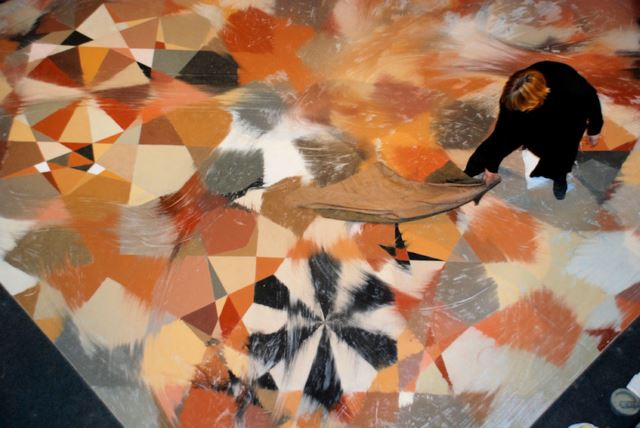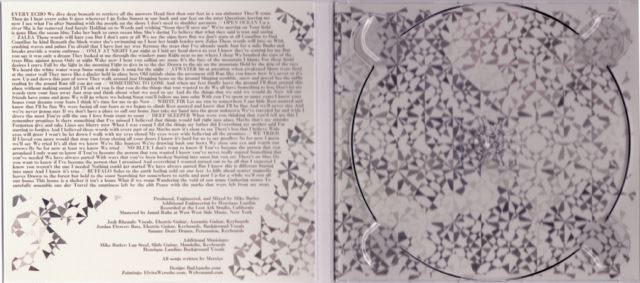Discover |  The sand paintings of Elvira Wersche: between installation and ritual |  | Judging from photographic material and direct visual impressions alone, you might assume that Elvira Wersche's work consists of large installations of scattered sand in complicated geometrical patterns. But these are brief moments in a far wider-ranging process, a cycle of alternating phases of apparent chaos, strung together to make one large performance. In fact no one will ever actually witness the complete performance, not even the artist herself. In that sense, Elvira's ‘sand performances' resemble large-scale collective rituals.
Most visitors see a sand pattern extending across the floor of an exhibition room. The installation is generally unfinished: visitors attend in the middle of a phase in which the artist is still engrossed. So large is the pattern that it is almost impossible to take in. You actually have to experience it by walking all around, seeing how the light plays with the sand, and how the artist adds new colours to the whole. The work looks like a gift. Seldom can the diversity and beauty of different hues of sand be experienced with such intensity. Constant movement is discernible in the pattern; depending on your vantage point and on where you choose to focus, new patterns and rhythms will emerge, some colours becoming more dominant while others recede into the background. For all the strict geometrical order, these patterns are open artworks that come to life in the observer's gaze. Such an installation is truly a sensation, in all senses of the word.
But shortly after the work is completed, visitors will experience a dramatic event. Wersche wipes the entire painting away. The colours mix like the paint in a painting, patterns become mere streaks and are eventually absorbed into the ill-defined colour of ‘just a heap of sand'.
Sometimes visitors are given a small quantity of sand to take home with them, as a parting memento. They know how significant that sand has been.
The total performance, the entire ritual, is lengthier still, and its content is more layered than I have described here.
The installations of scattered sand are not composed of arbitrary material, purchased or supplied by a company. The sand is collected under the artist's supervision. Her friends, fans and interested observers collect sand for her. In this context, ‘sand' is not defined simply as quartz – in geological terms, silicium oxide. It is everything that covers the earth's surface.
People collect it and give it to Wersche: her sand is truly a collection of gifts. People scoop up the sand, put it in a jar or an envelope, and send it to her with a note, frequently enclosing a photo by way of documentation. So in a sense, this represents the ultimate act of giving: the sand is picked up and immediately passed on.
The resulting collection is far from homogeneous. Some of the sand has been collected for its colour or appearance; other samples come from holy sites, places of pilgrimage, mountains with temples, or sacred caves. Then there is sand from places with some autobiographical significance or striking political associations. All this sand is brought together and preserved in all sorts of ways. This total collection in itself conveys a wealth of information, provides a picture of the world. It highlights places of current international importance as well as others that were important in the past.
This makes it a cultural-historical, political and philosophical document, and hence a statement. You might describe it as an atlas, an image of the world, as seen from the perspective and the position of Elvira Wersche.
To use this ‘sand atlas' in an installation requires a great deal of preparation. The installation is ultimately a response to three factors: the specific space in which the installation is to be created, the pattern designed beforehand, and the colours of the sand in the collection.
The space in which the sand is scattered may vary, but it takes on a near-ritualistic or sacred character as a result of the installation. Wersche's installations have been shown at various times in churches, a synagogue, museum rooms, and large exhibition halls. The size, shape, and play of light in each of these places determine a great deal, but equally important are the significance of the place to the visitor and artist alike.
Before this part of the process begins, the artist has already made a design: a geometrical pattern relying on principles familiar from the decorative shapes of Islamic art. These ornaments are arranged in a geometrical order expressing profound significance. The rules that determine the pattern are complex and themselves constitute statements about the world, about rhythm, evolution and order. They are rich in creative potential. That is clear from the fact that every point in the pattern may be a centre for all kinds of cyclically recurrent phenomena and ornaments. Each time you change the way you look, from which centre and in what direction, it creates fresh forms and layers in the pattern. As a result, the pattern is rather like a musical instrument, a harp that is made to sound by the addition of colour and is subsequently ‘listened' to by the viewer.
Colour is an essential part of this process. Wersche arranges her atlas by colours when she takes her boxes to a location to scatter the sand. When she starts, she sometimes discovers that the sand does not behave as expected: because of the light, it takes on a different colour, the scattering proves much easier or more difficult than anticipated, it may attract moisture or glisten more – or to be duller – than foreseen. The colour combinations are chosen with deliberation, producing a richness of colour that frequently leads viewers to assume that pigments have been added to the sand, which is absolutely not the case.
The eventual pattern is not just a visual artefact. It is a complex whole of voices telling stories – the stories of people who were in different parts of the world, for all sorts of reasons, places that in some cases carry powerful emotional connotations. The travelers who brought the sand have to some extent displayed their respect for those places by scooping the sand up there and taking it along with them. These places are juxtaposed in the installation and enter into a kind of mutual relationship.
Over the past few years, Elvira Wersche has developed a ritualized performance, combining many layers of meaning with strong visual moments. It revolves around the most humble material imaginable. This material prompts us to think about the genesis of colour and the significance of painting in its most primary form: we see it in a traveling workshop, on location, as a collection, and in an atlas. The sand is scattered to make patterns, the principles of which extend hundreds or thousands of years back in time. The significance of ornament and rhythm in art is shown here in a compelling way. The destruction of the image is also a spectacular ritual with a powerful visual impact. It seems to show how vulnerable this beauty is. But that is actually not the case. What remains is a story about a ritual. And what we know is that stories are the strongest works of art − indestructible as long as we carry on telling them. That is guaranteed by the people who present the artist with sand for her collection, and the visitors who go home with little envelopes of sand, each one labelled with a place and a date. For them, sand will never be the same again. What is more, they go home bearing a key – the key to discerning richness of colour in the humblest of places.
Elvira Wersche's performances are installations evoking a visual sensation, silent and abstract, and at the same time rituals pregnant with meaning, reflecting the cycle in the world that goes from random nature to order, then to chaos, a meaning achieved in a temporary ‘sacrifice'.
Michael van Hoogenhuyze
Leiden, September 2009
Michael van Hoogenhuyze is an art historian
attached to the Royal Academy of Art in The Hague |
|   | CD cover project |
|
|
| Contact the webmaster: webmaster@weltensand.com | Copyright © 2014. All rights reserved. | Last update Friday, September 11, 2020 |
|
|
|

